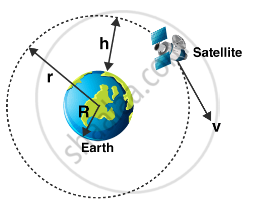Advertisements
Advertisements
Question
Is it possibe for a body to have inertia but no weight?
Solution
The weight of a body is the force with which it is attracted towards the centre of earth. When a body is stationary with respect to the earth, its weight equals gravity. This weight of the body is known as its static or true weight.
Inertia is a property of mass. Hence, a body can have inertia (i.e., mass) but no weight. Everybody always has inertia but its weight (mg) can be zero when it is taken at the centre of the earth or during free fall under gravity or a body placed at a very large distance from the earth. Basically, the weight of a body can be zero when acceleration due to gravity is zero, that condition is called weightlessness.

For example, When a satellite revolves in its orbit around the earth: Weightlessness possess many serious problems for astronauts. It becomes quite difficult for them to control their movements. Everything in the satellite has to be kept tied down. They can be displaced due to their inertia. The creation of artificial gravity is the answer to this problem
APPEARS IN
RELATED QUESTIONS
As the earth rotates about its axis, a person living in his house at the equator goes in a circular orbit of radius equal to the radius of the earth. Why does he/she not feel weightless as a satellite passenger does?
A body stretches a spring by a particular length at the earth's surface at the equator. At what height above the south pole will it stretch the same spring by the same length? Assume the earth to be spherical.
(a) Find the radius of the circular orbit of a satellite moving with an angular speed equal to the angular speed of earth's rotation. (b) If the satellite is directly above the North Pole at some instant, find the time it takes to come over the equatorial plane. Mass of the earth = 6 × 1024 kg.
Find the minimum colatitude which can directly receive a signal from a geostationary satellite.
Answer the following question.
Why is a minimum two-stage rocket necessary for launching of a satellite?
State the conditions for various possible orbits of satellite depending upon the horizontal/tangential speed of projection.
If the Earth-Sun distance is held constant and the mass of the Sun is doubled, then the period of revolution of the earth around the Sun will change to ____________.
If a body weighing 40 kg-wt is taken inside the earth to a depth to `1/2` th radius of the earth, then the weight of the body at that point is ____________.
A satellite is revolving in a circular orbit at a height 'h' above the surface of the earth of radius 'R'. The speed of the satellite in its orbit is one-fourth the escape velocity from the surface of the earth. The relation between 'h' and 'R' is ______.
Two satellites are orbiting around the earth in circular orbits of same radius. One of them is 10 times greater in mass than the other. Their period of revolutions are in the ratio ______.
